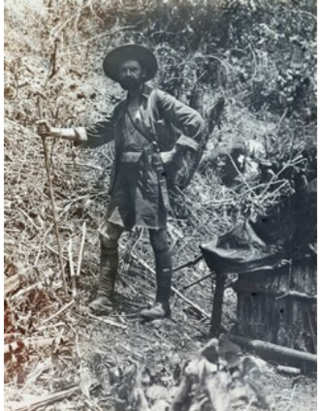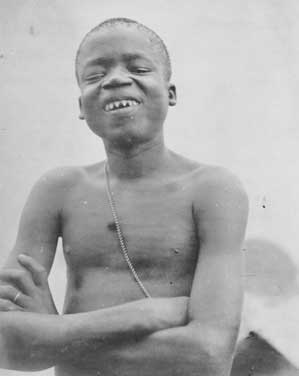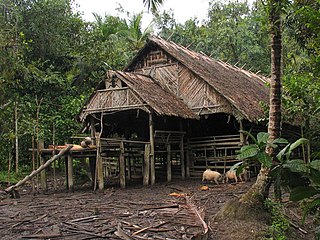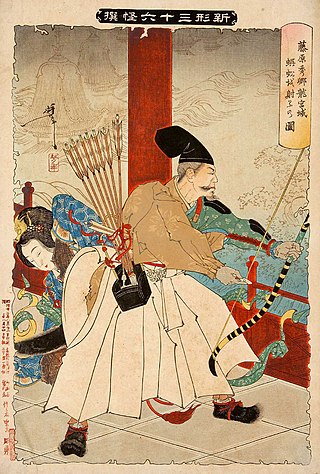
Archery is the sport, practice, or skill of using a bow to shoot arrows. The word comes from the Latin arcus, meaning bow. Historically, archery has been used for hunting and combat. In modern times, it is mainly a competitive sport and recreational activity. A person who practices archery is typically called an archer, bowman, or toxophilite.

A quiver is a container for holding arrows or bolts. It can be carried on an archer's body, the bow, or the ground, depending on the type of shooting and the archer's personal preference. Quivers were traditionally made of leather, wood, furs, and other natural materials, but are now often made of metal or plastic.

The bow and arrow is a ranged weapon system consisting of an elastic launching device (bow) and long-shafted projectiles (arrows). Humans used bows and arrows for hunting and aggression long before recorded history, and the practice was common to many prehistoric cultures. They were important weapons of war from ancient history until the early modern period, where they were rendered increasingly obsolete by the development of the more powerful and accurate firearms. Today, bows and arrows are mostly used for hunting and sports.

West Sumatra is a province of Indonesia. It is located on the west coast of the island of Sumatra and includes the Mentawai Islands off that coast. The province has an area of 42,119.54 km2 (16,262.45 sq mi), with a population of 5,534,472 at the 2020 census. The official estimate at mid 2022 was 5,640,629. West Sumatra borders the Indian Ocean to the west, as well as the provinces of North Sumatra to the north, Riau to the northeast, Jambi to the southeast, and Bengkulu to the south. The province is subdivided into twelve regencies and seven cities. It has relatively more cities than other provinces outside of Java, although several of them are relatively low in population compared with cities elsewhere in Indonesia. Padang is the province's capital and largest city.

The pig-tailed langur, monotypic in genus Simias, is a large Old World monkey, endemic to several small islands off the coast of Sumatra in Indonesia. Its face is black, its fur is black-brown and it has a relatively short tail. It is a diurnal species, feeding in the rainforest canopy on leaves, and to a lesser extent, fruit and berries. Little is known of its natural history, but it is heavily hunted, its populations have been declining rapidly and the International Union for Conservation of Nature has assessed its conservation status as being "critically endangered". It has been included on a list of the World's 25 Most Endangered Primates.

Mentawai people are the native people of the Mentawai Islands about 100 miles from West Sumatra province, Indonesia. They live a semi-nomadic hunter-gatherer lifestyle in the coastal and rainforest environments of the islands and are also one of the oldest tribes in Indonesia. The Mentawai population is estimated to be about 64,000. The Mentawai tribe is documented to have migrated from Nias – a northern island – to the Mentawai islands, living in an isolated life for centuries until they encountered the Dutch in 1621. The ancestors of the indigenous Mentawai people are believed to have first migrated to the region somewhere between 2000 and 500 BCE. The Mentawai language belongs to the Austronesian language family. They follow their own animist belief system called Arat Sabulungan, that links the supernatural powers of ancestral spirits to the ecology of the rainforest. When the spirits are not treated well or forgotten, they might bring bad luck like illnesses and haunt those who forgot them. Mentawai also have very strong belief towards objects they think are holy. The people are characterized by their heavy spirituality, body art and their tendency to sharpen their teeth, a practice they feel makes one beautiful. Mentawai tend to live in unison and peace with the nature around them because they believe that all things in nature have some kind of spiritual essence.

Lemang is a Minangkabau traditional food made from glutinous rice, coconut milk and salt, cooked in a hollowed bamboo tube coated with banana leaves in order to prevent the rice from sticking to the bamboo. Originating in Indonesia, it is also found in Singapore, Malaysia, and Brunei, as similar dishes made from sticky rice in bamboo are common throughout Mainland Southeast Asia.

Cecil Boden Kloss was an English zoologist. He was an expert on the mammals and birds of Southeast Asia. The Rubiaceae genus Klossia was named after him.

The Mentawai langur is a species of primate in the family Cercopithecidae. It is endemic to the Mentawai Islands in Indonesia. Its natural habitat is subtropical or tropical dry forests. The Siberut langur was formerly considered a subspecies of the Mentawai langur.

In archery, a recurve bow is one of the main shapes a bow can take, with limbs that curve away from the archer when unstrung. A recurve bow stores more energy and delivers energy more efficiently than the equivalent straight-limbed bow, giving a greater amount of energy and speed to the arrow. A recurve will permit a shorter bow than the simple straight limb bow for given arrow energy, and this form was often preferred by archers in environments where long weapons could be cumbersome, such as in brush and forest terrain, or while on horseback.
Ya is the Japanese word for arrow, and commonly refers to the arrows used in kyūdō. Ya also refers to the arrows used by samurai during the feudal era of Japan. Unlike Western arrows, the ya is close to a metre long or longer. Traditional ya are made from natural materials, usually bamboo, while modern ones may use aluminium or carbon fiber.

Human tooth sharpening is the practice of manually sharpening the teeth, usually the front incisors. Filed teeth are customary in various cultures. Many remojadas figurines found in part of Mexico have filed teeth and it is believed to have been common practice in their culture. The Zappo Zap people of the Democratic Republic of Congo are believed to have filed their teeth.
Reimar Schefold, is professor emeritus of cultural anthropology and sociology of Indonesia at Leiden University. His special interests are thematic symbolic anthropology, cultural materialism, vernacular architecture, and social change among ethnic minorities. He has lectured and written about diversity and commonality amongst the inhabitants of the islands off the coast of West Sumatra.

The Sakuddei or Sabiroet people are an ethnic group, one of at least eleven, on the island of Siberut, Indonesia. Siberut is the northernmost of the Mentawai Islands which are located 130 km (81 mi) to the west off the coast of Sumatra. The Sakuddei live in south-central Siberut in an egalitarian society, cut off from the outside world. They speak a dialect of the Malayo-Polynesian Mentawai language.

Uma are traditional vernacular houses found on the western part of the island of Siberut in Indonesia. The island is part of the Mentawai islands off the west coast of Sumatra.

Yebira, Ebira and Shiko are types of quiver used in Japanese archery. The quiver is unusual in that in some cases, it may have open sides, while the arrows are held in the quiver by the tips which sit on a rest at the base of the ebira, and a rib that composes the upper part and keeps them in place.

Telur pindang or pindang eggs are hard boiled eggs cooked in the pindang process, originating from Javanese cuisine, Indonesia, and popular in Malay as well as Palembang cuisine. The eggs are boiled slowly in water mixed with salt, soy sauce, shallot skins, teak leaf and other spices. Due to its origins, it bears striking similarities with Chinese tea eggs. However, instead of black tea, this version uses leftover shallot skins, teak leaves or guava leaves as dark brownish coloring agents.

Palitai is the traditional knife of the Mentawai people, originating from the Mentawai Islands off West Sumatra, Indonesia.

Kurabit is a traditional shield originating from the Mentawai Islands off the coast of West Sumatra, Indonesia.

Sumpit or sumpitan are general terms for blowguns, usually tipped with iron spearheads, used for hunting and warfare in the islands of the Philippines, Borneo, and Sulawesi. They were also known as zarbatana by the Spanish.





















